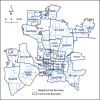Identifying a spatial scale for the analysis of residential burglary: An empirical framework based on point pattern analysis
- PMID: 35226707
- PMCID: PMC8884495
- DOI: 10.1371/journal.pone.0264718
Identifying a spatial scale for the analysis of residential burglary: An empirical framework based on point pattern analysis
Abstract
A key issue in the spatial and temporal analysis of residential burglary is the choice of scale: spatial patterns might differ appreciably for different time periods and vary across geographic units of analysis. Based on point pattern analysis of burglary incidents in Columbus, Ohio during a 9-year period, this study develops an empirical framework to identify a useful spatial scale and its dependence on temporal aggregation. Our analysis reveals that residential burglary in Columbus clusters at a characteristic scale of 2.2 km. An ANOVA test shows no significant impact of temporal aggregation on spatial scale of clustering. This study demonstrates the value of point pattern analysis in identifying a scale for the analysis of crime patterns. Furthermore, the characteristic scale of clustering determined using our method has great potential applications: (1) it can reflect the spatial environment of criminogenic processes and thus be used to define the spatial boundary for place-based policing; (2) it can serve as a candidate for the bandwidth (search radius) for hot spot policing; (3) its independence of temporal aggregation implies that police officials need not be concerned about the shifting sizes of risk-areas depending on the time of the year.
Conflict of interest statement
The authors have declared that no competing interests exist.
Figures








References
-
- Weisburd D. The law of crime concentration and the criminology of place. Criminology. 2015;53: 133–157. doi: 10.1111/1745-9125.12070 - DOI
-
- Ackerman WV, Murray AT. Assessing spatial patterns of crime in Lima, Ohio. Cities. 2004;21: 423–437. doi: 10.1016/j.cities.2004.07.008 - DOI
-
- Andresen MA, Malleson N. Spatial heterogeneity in crime analysis. In: Leitner M, Leitner M, editors. Crime Modeling and Mapping Using Geospatial Technologies. Dordrecht; 2013. pp. 3–23. doi: 10.1007/978-94-007-4997-9_1 - DOI
-
- Boessen A, Hipp JR. Close‐ups and the scale of ecology: land uses and the geography of social context and crime. Criminology. 2015;53: 399–426.
-
- Brantingham PJ, Dyreson DA, Brantingham PL. Crime seen through a cone of resolution. Am Behav Sci. 1976;20: 261–273.
MeSH terms
LinkOut - more resources
Full Text Sources

